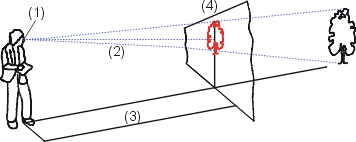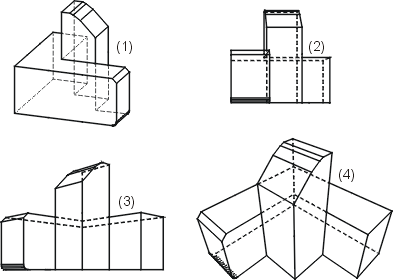Central Projection
Views > Projections > Standard AXO > Central projection...
Central projection - also called vanishing point perspective - takes into account the impression of tapering compared with parallel projection. Object parts which lie in front of the image plane are enlarged, while those lying behind the image plane are reduced. Object parts that lie in the image plane remain undistorted.
The following concepts are important for defining central projection:
- Spatial
centre SC
Point of the image plane on which the eye of the observer is focused. The SC is always in the centre of the screen with central projection. - Viewpoint O
Eye of the viewer. - Line
of vision
Distance between viewpoint and spatial centre. - Point on horizon
H
Straight line on which the vanishing points of the coordinate axes lie. It specifies the position of the x-axis of the image plane. - Viewer
distance
Distance of the viewer from the image plane. - Angle
of vision
Ratio of viewer distance O-SC: Width of the image plane

(1) Viewpoint (2) Visual ray, (3) Viewer distance, (4) Image plane

Horizon

(1) Original model, (2) One-point projection (2) Two-point projection (3) Three-point projection
The following central projection functions are available:
|
|
|
|
|
|
|
|
|
|
|
|
|
|
|
|
|
|
|
|
![]() When working in the central projection, not all point options may be available, e.g. the point option (Z) Centre. Therefore, a creation and processing of 3-D models in the central projection is not recommended.
When working in the central projection, not all point options may be available, e.g. the point option (Z) Centre. Therefore, a creation and processing of 3-D models in the central projection is not recommended.

View Functions (3-D) • Axonometric and Isometric Projections (3-D) • Projection Methods (3-D)







